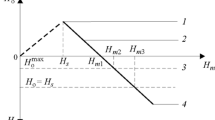Abstract
The magnetic after-effect caused by the diffusion of electrons was studied in detail in MnMg ferrites of the series Mg x Mn1.15−x Fe1.85O4+γ ; the comparative measurements were also carried out on a sample of MgFe2O4+γ(γ<0). By combining the two methods, (a) investigation of the disaccommodation of initial permeability at different temperatures and (b) measurement of the displacement of the maximum of the temperature dependence tanδ with the frequency, it was possible to study the relaxation processes whose time constants lay between 0.5 sec and several hours, or between 10−4 to 10−7 sec. It was found that the processes taking place at low temperatures and studied by method (a) differ from those observed at high temperatures by method (b), particularly in the lower activation energies and greater dispersion of the time constants. In addition to these two main relaxation processes a weak relaxation superposed over the main disaccommodation was found in ferrites with non-zero content of manganese. An analysis of the intensity of different relaxation effects showed the participation of Mn ions in these relaxation effects and it was found that both main relaxations are probably equivalent as regards the final steady state, to the creation of which they lead; they differ however in the mechanism of electron diffusion by which this state is realized. The main features of the different diffusion mechanisms are discussed.
Abstract
Магнитная релаксация, вызванная диффузией электронов, была подробно изучена у MnMg ферритов ряда Mg x Mn1.15−x Fe1.85O4+γ . Сравнительное измерение было проведено также на образце MgFe2O4+γ (γ<0). Комбинация двух методов (а)-исследование дезакомодации начальной магнитной восприимчивости при различных температурах, (б) измерение сдвига максимума температурной зависимости tgδ с частотой, дала возможность исследовать релаксационные эффекты, постоянные времени которых оказались между 0,5 sec и несколькими часами, или между 10−4–10−7 sec. Было установлено, что явления, возникающие при более низких температурах и изучаемые методом (а) отличаются от, явлений, наблюдаемых при более высоких температурах методом (б), отличаются, главным образом, энергиями активации и большей дисперсией постоянных времени. Наряду с этими двумя главными эффектами релаксации была найдена у ферритов с ненулевым содержанием марганца еще слабая релаксация, наложенная на главную дезакомоданию. На основе разбора интенсивности отдельных эффектов релаксации было доказано участие ионов Mn в этих явлениях релаксации и было показано, что обе главные релаксации, вероятно, являются эквивалентными, пока речь идет о конечном стационарном состоянии, к возникновению которого способствуют; отличаются они, однако, механизмом электронной диффузии, благодаря которой это состояние осуществляется. Обсуждаются основные черты отдельных механизмов диффузии.
Similar content being viewed by others
References
Snoek J. L.: New Developments in Ferromagnetic Materials, Elsevier Pub. Co. Inc., 1949, p. 54.
Wijn H. P. J., Heide H. van der: Rev. Mod. Phys.25 (1953), 98; Smith J., Wijn H. P. J.: Advances in Electronics and Electron Physics VI, Acad. Press, New York 1954.
Clogston A. M.: Bell Syst. Tech. J.34 (1955), 739.
Kienlin A. v.: Z. f. angew. Phys.9 (1957), 245.
Krupička S., Vilím F.: Czech. J. Phys.7 (1957), 723.
Enz U.: Physica24 (1958), 68.
Krupička S.: Proceedings of the International Conference on Solid State Physics in Electronics and Telecommunications, Brussels June 1958; Acad. Press London (at press).
Gieseke W., Z. f. angew. Physik11 (1959), 91.
Köhler D.: Z. f. angew. Physik11 (1959), 103.
Richter G.: Ann. d. Physik26 (1937), 605;32 (1938), 683.
Snoek J. L.: Physica5 (1938), 663;8 (1941), 711;9 (1942), 862.
Néel L.: Jour. de Phys. et Rad.13 (1952), 249.
Néel L.: J. Appl. Phys., Supplement to Vol.30 (1959), 3S (Proceedings of the Fourth Symposium on Magnetism and Magnetic Materials, Nov. 17–20, 1958, Philadelphia).
Verwey E. J. W., de Boer J. H.: Rec. trav. chim. Pay-Bas55 (1936), 531; see also e.g. van Uitert L. G.: Proc. IRE44 (1956), 1294.
Galt J. K.: Bell Syst. Techn. J.33 (1954), 1023.
Gorter E. W.: Philips. Res. Rep.9 (1954), 295.
Goodenough J. B.: Colloque International de Magnétisme, Grenoble — 2–6 July 1958. J. de Phys. et le Radium20 (1959), 155.
Baltzer P. K., White J. G.: J. Appl. Phys.29 (1958), 445.
Krupička S., Závěta K.: Czech. J. Phys.9 (1959), 324.
Brož J., Krupička S., Závěta K.: Czech. J. Phys.9 (1959), 481.
Krupička S., Závěta K.: J. Electronics and Control6 (1959), 333.
Miller A.: Conference on Magnetism and Magnetic Materials, Detroit, November 1959, J. Appl. Phys. Suppl. to Vol.31 (1960), 261S.
Brož J., Krupička S., Zítka B.: Czech. J. Phys.9 (1959), 314.
Vilím F.: to be published.
Bosman A. J., Brommer P. E., Van Daal H. J., Rathenau G. W.: Physica23 (1957), 989.
Krupička S.: Czech. J. Phys.B 10 (1960), 40.
Becker R.: Z. f. Physik33 (1925), 185; Becker-Döring: Ferromagnetismus, Springer, Berlin 1939, p. 242.
Jahnke-Emde: Tabellen höherer Funktionen, publ. house: Teubner, Leipzig 1952.
Brissonneau P.: C. R. Acad. Sci (Paris)244 (1957), 1174, J. Phys. Ghem. Solids7 (1958), 22.
Feldtkeller R., Hettich H.: Z. f. angew. Physik2 (1950), 494.
Marais A., Merceron T.: C. R. Acad. Sci (Paris),248 (1959), 2976.
Brož J.: Czech. J. Phys., Czech. J. Phys.B 10 (1960), 428.
Kaczér J.: Izv. AN SSSR, ser. fiz.21 (1957), 1170.
see e. g. Vonsovskij -Šur: Ferromagnetizm; Gos. Izd. Moscow 1948, p. 395.
Bozorth R. M., Tilden E. F., Williams A. J.: Phys. Rev.99 (1955), 1788; Dillon J. F., Geschwind S., Jaccarino V.: Phys. Rev.100 (1955), 750; Rado G. T., Folen V. J.: J. Appl. Phys.29 (1958), 438; see also Smit-Wijn: Ferrites, Philips Techn. Library 1959, p. 163.
Krupička S.: Czech. J. Phys.7 (1957), 769.
Heikes R. R., Johnston W. D.: J. Chem. Phys.26 (1957), 582; Jonker G. H.: J. Phys. Chem. Solids9 (1959), 165.
Gurney R. W., Mott N. F.: Proc. Phys. Soc. (London)49 (1957), supplement, 32.
Author information
Authors and Affiliations
Additional information
In conclusion the author thanks Dr. J. Brož and K. Závěta for valuable discussion and F. Vilím for carefully carrying out the measurements.
Rights and permissions
About this article
Cite this article
Krupička, S. Study of magnetic after-effect in magnesium manganese ferrites. Czech J Phys 10, 782–810 (1960). https://doi.org/10.1007/BF01557864
Received:
Issue Date:
DOI: https://doi.org/10.1007/BF01557864



